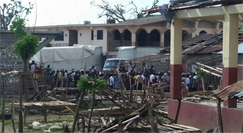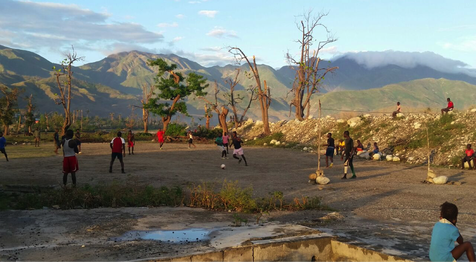adapted from a presentation to the HOMER Energy Microgrid Conference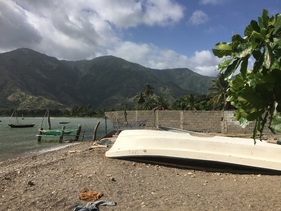 by Rachel McManus EarthSpark is a US based non-profit with the mission of eradicating energy poverty. Our method is to do the r&d on business models that can spin off and scale. We’ve already spun off SparkMeter, a smart metering technology company along with Enèji Pwòp, a Haitian social enterprise. And we are now working on a business model for microgrids. This is Haiti, where we work. Haiti is a beautiful, vibrant Caribbean country that also happens to be the second independent state in the Western hemisphere and the only born of a slave rebellion. The narrative we often hear is of devastating stories about Haiti so we want to start with the positive. This blog will talk about our experiences during and after Hurricane Matthew but also highlight two main things: first of all that microgrids for energy access are really hard. And secondly that microgrids for energy access are essential to local resilience. Now is a really exciting time for building the models that can scale to solve pieces of very big problems! 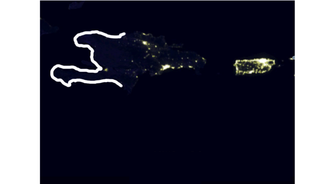 This is also Haiti. Only about 30% of the country has access to electricity. And there are several groups working on energy access solutions there and a portfolio of technologies and products will ultimately solve the energy access problem. Things were going well for the Les Anglais microgrid. Inaugurated in June 2015, the grid served 450 homes and businesses with electricity 24/7. Customers were saving 50-80% over what they were paying before for kerosene lamps, third party phone charging and small diesel generators. We signed a 9-year concession with our next town and had begun the process of community engagement and household mapping. 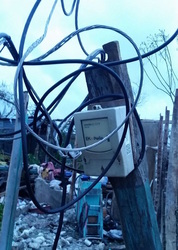 Of course though, things were not perfect. Haiti has been going through an electoral crisis and we were also dealing with theft, among many other issues (we’ll be writing more about our experience with theft protection soon!). Even to get to the point of having a grid we had to develop our own smart metering technology. Things got even more difficult when Matthew, a category 4 hurricane made landfall in Les Anglais at the beginning of October. In the days before the storm, we prepared the grid the best we could. We let the community know in advance that we would have to shut down the grid so that they could charge their phones and radios, we placed sandbags at the generation site, shut off the grid and found safe spaces for our staff. After the storm passed we had 3 days of no communication before we could learn what had happened. When we made contact, the information we received was devastating. Most people in Les Anglais had lost their homes; we even lost the roof of our own house. Approximately 90 people were killed though we are extremely grateful to find out that all of our staff members were safe. Aside from preparing immediately before the storm hit, we had built a high-quality system. Our solar panel array was rated for a category 4 storm. We had also made sure not to connect houses to the grid that were in precarious locations. One area of town that we didn’t connect to the grid, Bo Lagon, was sadly wiped away before the storm even hit. In the end, the grid fared comparatively well. In terms of our generation system, we lost about 40% of our panels but the power electronics and battery bank were left unscathed. The distribution system, however, will have to be completely redone. As most of our customers lost their homes it will be a while before we can reconnect them.
It would have been wonderful to be able to say today that our microgrid was up and running and more resilient than the unreliable national grid. But when all your customers have lost their houses, it’s not that easy. Our generation system can be up any day now, but we think it will be about 6-9 months before homes are in place and the distribution system is rebuilt to provide power to our customers. However, all of this also shows why infrastructure is so important. As relief took place, we saw how lack of infrastructure and planning – poor roads and lack of stored food supplies to name a few, made reaching those in need more difficult. To break from the difficulties of systemic poverty, infrastructure is so crucial. We see integrated electrification as part of a bigger picture of 'integrated economic and environmental resilience' that links to other sectors like roads/transportation, communications, and building materials/practices.  A business in Les Anglais selling ice and phone charging using a solar panel. A business in Les Anglais selling ice and phone charging using a solar panel. We have to admit that solutions even more decentralized than our grid – such as solar lanterns and small generators - met basic needs better after Matthew. Because people need energy services, not just energy access. We need to be building sustainable, long-term infrastructure, including sustainable energy services that can unlock economic potential with higher levels of power so that we aren’t always just meeting basic needs in developing countries. EarthSpark is working on getting our microgrid powering homes and businesses as and when the community rebuilds. It’s not easy and there is a lot of risk involved, but our work also holds so much potential for not only solving energy access in Haiti but also unlocking deeper economic security and quality of life for the regions we serve.
0 Comments
Your comment will be posted after it is approved.
Leave a Reply. |
EarthSpark supporters make our work possible. Thank you for considering a donation towards eliminating energy poverty in Haiti.
Read the full blog - click here!
|
EarthSpark International is a non-profit 501(c)3 organization.


